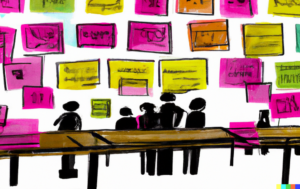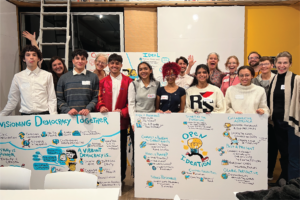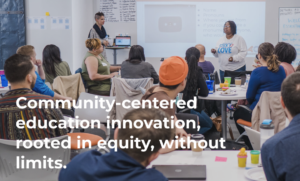We Inherited a Factory but We Need a Design Studio (and 9 Other Problems)

Naming the problems we face is the first step towards building something better. In US education, we’ve got a stack of gnarly intertwined problems. Here’s a list of 10.
1. We inherited a factory. With a focus on compliance and routine, we inherited a factory but we need a design studio. We inherited rules, bells, tests, and credit requirements that all get in the way of growing capable human beings. Hey, don’t get me wrong, good things happen inside the education factory every day, but it’s like playing baseball on a golf course, the setup is all wrong.
2. Goals. The goals of the factory were obedience and knowledge transfer. It efficiently sorted the noncompliant. Now that knowledge is widely accessible and initiative is more important than obedience, we need new goals for education–a new more relevant sense of purpose.
Moving beyond the basics requires a community conversation about what’s happening and how to prepare–or better yet, how to help youth contribute to community vitality starting today. Communities around the country–and around the world–are having productive conversations leading to new goals and graduate profiles.
At the top of our list are three literacies for the innovation economy:
- Design skills: an iterative problem-solving approach;
- Entrepreneurship skills: taking initiative and learning to deliver value; and
- Social skills: collaborating on diverse teams.
3. Gravity. OK, now that we’ve got the goals right we have to acknowledge the immense gravity of the factory system. Old buildings with narrow hallways and small classrooms with desks in rows just oozes tradition. Layers of local, state, and federal policy reinforce and outdated training add to the weight. An even bigger boat anchor is our collective and idealized memory of school. You know, “It worked for me, so it’s good enough for junior.”
It’s important to weigh the gravity of the factory system because it takes political capital to change the system (or,as Gordan MacKenzie said, to leave the orbit of the giant hairball). You need to start building your political capital bank account if you want to attack the gravity of the system we inherited.
4. Business model. In many parts of K-12 and HigherEd we’re experiencing declining enrollments and increasing costs–a bad combination for fiscal management. Add the odd governance structure in America with 14,000 school districts and you have a big business model problem.
Enrollments will continue to decline (owing to slowing birth-rate and immigration and more learning options) and pressure on state budgets will increase so new investment isn’t likely.
Given the importance of relationships to learning, we experience Baumol’s cost disease–little or no labor productivity and rising costs in service delivery. New tools and staffing models aren’t going to help much.
But we do have a big opportunity when it comes to improve quality and reduce cost in administration (see a dozen lean district service delivery opportunities).
5. Complexity. It has been hard enough trying to figure out how to personalize for basic skills and now we’re trying to customize on a broader set of outcomes (e.g., MyWays competencies). The work is enormously complex pedagogically, financial, politically, and in terms of staffing, structures, and schedules.
Schools working in networks of like-minded schools makes it easier for more schools to deploy sophisticated learning models. It will be an important part of nimble efficient high performing systems (addressing #, 5he business model problem).
6. Invention. We need a new core technology in education–new measures of learning, better ways to capture and communicate expanded human capability, something much better than time in a seat and a list of courses passed.
The big opportunity, as David Conley discusses in his new book on next-gen assessment is “cumulative validity.” Good schools take advantage of a lot of data points over time to understand student achievement and growth. We need to take advantage of all the formative data we’re collecting and stop wasting time, energy and focus on bad testing.
But this is a tough problem. We’ll have to build big data sets while protecting privacy; we’ll have to solve interoperability; we’ll have to develop new methods of comparability so that we can compare students learning in different systems. The tech is the easy part compared to the politics.
We also need to equip young people with better signaling tools than a GPA and a list of courses. Badges that reflect units of demonstrated competence with real evidence attached would be a good start. A published (and verified) portfolio of personal bests would be a great addition.
7. Lack of R&D capacity. We have very little R&D investment or capacity in the sector. There’s not enough basic research and, unlike biotech, new EdTech tools are often not linked to basic research (the Digital Promise Learner Variability Project is a good start).
8. Speed. Working in phases is important but we often accept a pace that does students a disservice. We assume we have to change the whole system; we think we have to wait until the next school year to start something or we use equity as an excuse (we can’t do it everywhere so we won’t do it).
When it comes to pilot projects, former Albemarle County superintendent Pam Moran suggests, “Aim small. Miss small.” She favors an iterative approach to innovation. Moran said don’t let a plan block opportunity. “We pivot fast to stand up new idea,” explained Moran.
9. Unintended consequences. In my 60th year, I’ve become circumspect about the fact that every well-intentioned fix comes with some unintended consequences. Take NCLB for example, it was a great example of equity-focused bi-partisan legislation. The bargain was flawed and without the anticipated fixes, it grew stale, then dangerous.
Adding a reflection step to the process, like the K12 Lab of Stanford’s d.School suggests (below) is an opportunity to ask, “What are the possible unintended consequences of our proposed solution?”
 10. Concentration of poverty. Last, I want to acknowledge the challenges of poverty, especially the concentrated generational poverty that many communities experience. As Raj Chetty has noted, where you grow up matters.
10. Concentration of poverty. Last, I want to acknowledge the challenges of poverty, especially the concentrated generational poverty that many communities experience. As Raj Chetty has noted, where you grow up matters.
It’s encouraging that we’re learning more about the impacts of trauma and adverse childhood experiences but it also makes the problem seem larger and more pressing than ever.
Because our communities are so segregated, it’s hard to create schools that are racially and socioeconomically diverse. I’m afraid increasing inequality will make this problem worse.
So, what do we do? We’ve learned a lot about opening good new schools in communities that need them. We’re still learning about transforming those inherited factories into design studios.
The point is this: to make things better, we need to name and frame the problems we face. That’s the first step in design thinking. The next step is empathy research. Make the problems real by talking to kids and teachers about what’s really going on. Then comes the fun stuff, ideating and prototyping around updated goals. We need a lot more of that. Let’s get busy.
Key Takeaways from the Podcast
[1:21] Tom kicks off this week’s episode by talking more about today’s topic.
[2:12] The first problem at hand: transforming an inherited factory-model school into a design studio.
[2:57] Problem #2: the rules at these factory-model schools and moving beyond basic requirements.
[3:56] Problem #3: the gravity of the factory-model system inherited.
[5:48] Problem #4: the business model.
[7:54] Problem #5: the complexity of transformation.
[9:06] Problem #6: the technology/invention problem; the need for new measures of learning and better ways to capture and communicate expanded human capabilities.
[11:31] Problem #7: the serious lack of research and development (R&D).
[12:53] Problem #8: the speed problem — work is progressing too slow!
[14:36] Problem #9: the flaws of well-intentioned efforts.
[15:46] Problem #10: the challenges of poverty and inequality.
Mentioned in This Episode
- Orbiting the Giant Hairball: A Corporate Fool’s Guide to Surviving with Grace, by Gordon MacKenzie
- The Promise and Practice of Next Generation Assessment, by David T. Conley
- Mastery Transcript Consortium
- Virginia School Consortium for Learning
- What 100 School Visits Taught Us This Year
For more, see:
- What Should Graduates Know and Be Able to Do? (A conversation with Ken Kay)
- Better Together: Why Schools Should Work in Networks
Stay in-the-know with innovations in learning by signing up for the weekly Smart Update






Gary Gruber
Great outline of issues and takeaways. My recommendation is that when a specialist is needed, you call in the best you know or can find and there are several out there in the marketplace with the skills, foresight, experience and credibility that can help. Besides the d-School at Stanford, IDEO and some other very well-known folks, I think of several others who are doing excellent work in this arena: Christian Long at Wonder by Design; Bob Dillon (DrRobertDillon); this resource: https://issuu.com/perkinswill/docs/perkins_will_k12education and the DALHOFF THOMAS design studio
Patti Shade
Creativity Skillsets and Mindsets . . . a 4th literacy fir consideration.